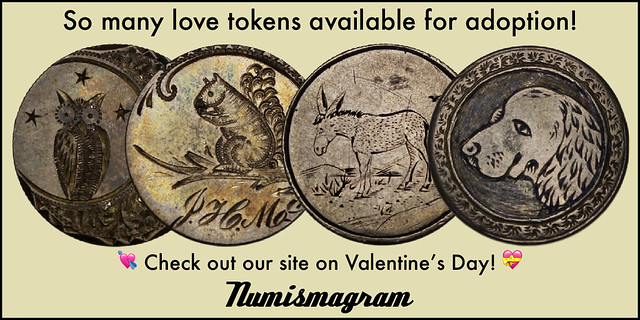
PREV ARTICLE
NEXT ARTICLE
FULL ISSUE
PREV FULL ISSUE
VOCABULARY TERM: HUBBING PRESSDick Johnson submitted this entry from his Encyclopedia of Coin and Medal Terminology. Thanks. -Editor Hubbing Press. A press of tremendous power, used to duplicate a design in metal from a hard master to a soft steel block. Also called multiplying press, such a press is employed to duplicate dies by forcing two steel blocks into each other, called a squeeze. One steel block contains the design to be reproduced, it is hardened. The other steel block has been prepared to receive the design by: (1) smoothing the top and bottom, making the two surfaces absolutely parallel, (2) machining a cone or dome on the top, (3) polishing smooth the cone or dome surface to receive the design, and (4) by annealing the steel until die body is dead soft. The hub and the prepared die block are placed within a hubbing retainer, a collar to hold the two in correct alignment during the squeeze. Early screw presses were employed to do basic hubbing and continued to be used for nearly 400 years. In the 19th century specialized screw presses were built to do only hubbing by making heavier frames, longer cross beams and counterweights for greater leverage. In the 20th century hubbing presses have seen their greatest improvement, with greater pressure by hydraulic power and compressed oil or water in a closed chamber providing the powerful force. History of hubbing presses. Very primitive hubbing occurred by forging a hard steel into a soft steel with a heavy hammer blow; this was how hubbing was use until the early 16th century. Undoubtedly when the first screw presses was developed (about 1506) the same press used for striking would also be used for hubbing (if the screw press operator could exert enough pressure). The U.S. Mint accomplished this by removing the feed and ejection mechanisms of the steam powered press to do the hubbing. Manual screw presses were used from the 16th century even up to the 20th century. However once the collar and ejection system, or the automatic feed and delivery mechanism were installed into the screw press for striking (both developed about 1790), the press used for striking was no longer available for hubbing. Thus mints required separate screw presses, the largest and strongest was reserved for hubbing, all others for coining. The Royal Mint, London, developed a specialized screw press used only for hubbing in the early 1850s. Hubbing requires two to three times the pressure used to strike coins, but this was accomplished by man power. Two stout men were required on opposite ends of a balance beam, by pressing on the beam and walking in a circle around the press drove the shank downward (by spindle threads). The hub and die blank were pressed into each other to effect the squeeze. Hubbing presses were made of heavy frames, with longer beams and counterweights added to gain more leverage. It was only when hubbing presses became hydraulic (and operated by electricity after 1890) that manually operated hubbing presses with screw mechanism were replaced, although the British Royal Mint had an electrified screw press in the 1950s and 1960s which it used for hubbing. Modern hubbing press characteristics. The modern hubbing press contains a bed, two shanks, and a gauge to indicate the power derived by the hydraulic force. Hubbing presses for coin and medal die hubbing range from 300 to 1000 tons pressure per square inch. The time in which the squeeze occurs (closing speed) is important – slower is better – and modern presses have been improved to control not only the closing speed but also to control a longer dwel when the shanks are fully extended (this allows more flow time for surface movement). Also modern hubbing presses control initial impact, pressing speeds, pressure, thickness and depth penetration. Specialized hubbing presses can also be either upstroke or downstroke – the direction in which the power is derived. A lever turns on/off the hydraulic valve; when turned on the hydraulic power forces the two shanks, one with the bed containing the hub and die, together. Modern presses have the hubbing occur behind a glass door. The glass is bulletproof. Hubs and dies could break during hubbing and they sometimes explode in all directions. Should such die shrapnel hit a person it is powerful enough to kill. Thus hubbing presses are quite dangerous and are operated only by trained pressmen. Every precaution is taken that the hubbing be accomplished by safe techniques. References: C66 {1988} Cooper pp [early] 159-165, [modern] 235.
Looking for the meaning of a numismatic word, or the description of a term? Try the Newman Numismatic Portal's Numismatic Dictionary at: https://nnp.wustl.edu/library/dictionary Or if you would like a printed copy of the complete Encyclopedia, it is available. There are 1,854 terms, on 678 pages, in The Encyclopedia of Coin and Medal Technology. Even running two a week would require more than 19 years to publish them all. If you would like an advance draft of this vital reference work it may be obtained from the author for your check of $50 sent postpaid. Dick Johnson, 139 Thompson Drive, Torrington, CT 06790.  Wayne Homren, Editor The Numismatic Bibliomania Society is a non-profit organization promoting numismatic literature. See our web site at coinbooks.org. To submit items for publication in The E-Sylum, write to the Editor at this address: whomren@gmail.com To subscribe go to: https://my.binhost.com/lists/listinfo/esylum All Rights Reserved. NBS Home Page Contact the NBS webmaster 
|